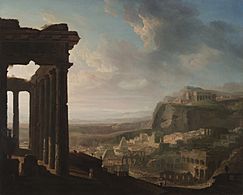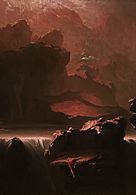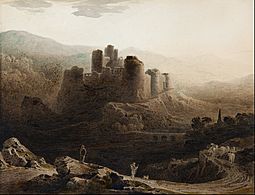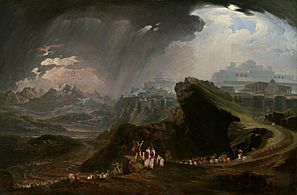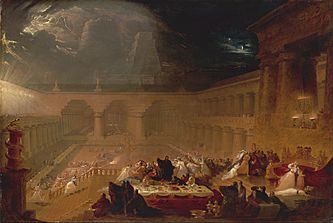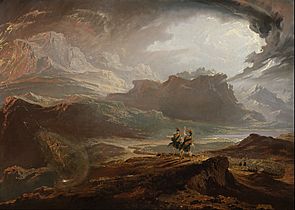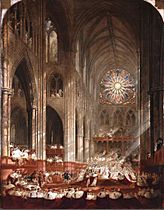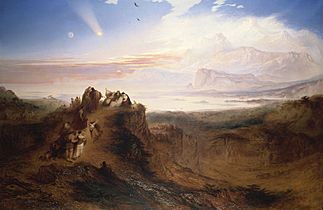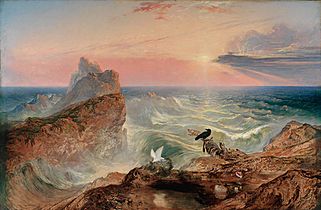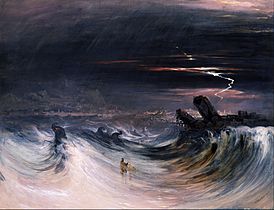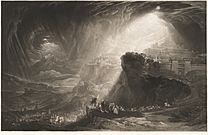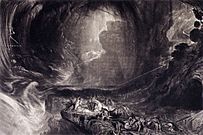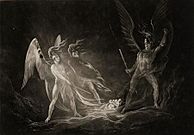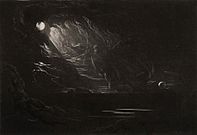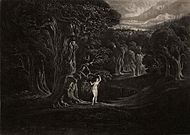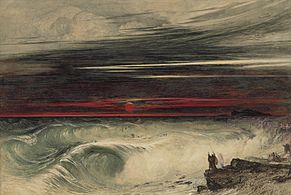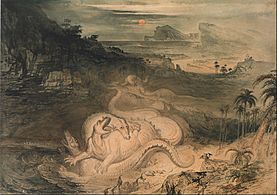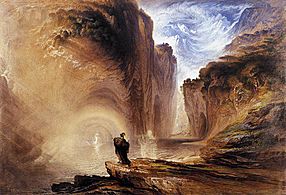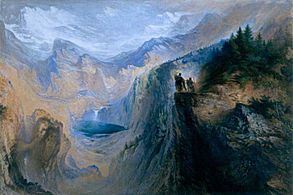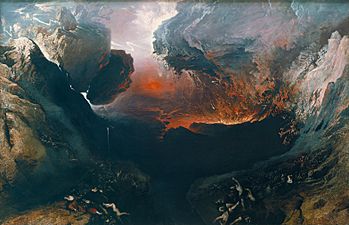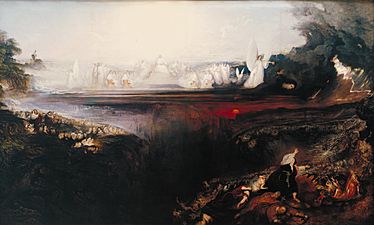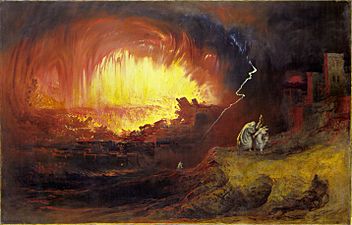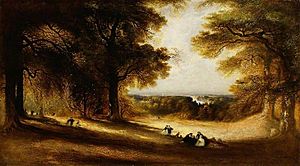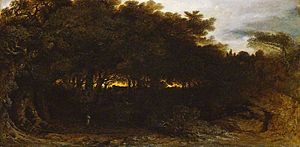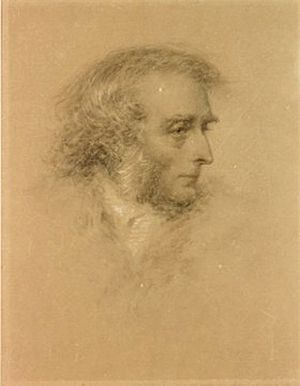John Martin (painter) facts for kids
Quick facts for kids
John Martin
|
|
|---|---|

Portrait of John Martin by Henry Warren (1839)
|
|
| Born | 19 July 1789 |
| Died | 17 February 1854 (aged 64) |
| Known for | Painting, engraving, illustration |
| Movement | Romantic |
| Spouse(s) |
Susan Martin
(m. 1818) |
John Martin (born July 19, 1789 – died February 17, 1854) was an English artist. He was a Romantic painter, engraver, and illustrator. Martin was famous for his huge, dramatic paintings. These often showed religious scenes or amazing fantasy worlds. His artworks usually featured tiny people in grand, imposing landscapes.
Martin's paintings and the prints made from them were very popular. In 1821, a famous painter named Thomas Lawrence called him "the most popular painter of his day." However, some art critics, like John Ruskin, didn't like his work as much.
Contents
Early Life and Family
John Martin was born in July 1789. He grew up in a small cottage in Haydon Bridge, near Hexham in Northumberland, England. He was the fourth son of Fenwick Martin, who used to be a fencing teacher.
When he was young, John was sent to learn how to paint coats of arms for carriages. This was in Newcastle upon Tyne. But there was a disagreement about his pay, so he left. He then studied under an Italian artist named Boniface Musso.
In 1806, Martin moved to London with his teacher. He got married at 19 years old. To earn money, he gave drawing lessons. He also painted with watercolors and on china and glass. He spent his free time studying perspective and architecture.
John had three older brothers. William was an inventor. Richard was a soldier who fought in the Peninsular War and at Waterloo. Jonathan was a preacher who suffered from mental illness. He famously set fire to York Minster in 1829.
Becoming an Artist
Martin started by painting sepia watercolors to earn more money. In 1810, he sent his first oil painting to the Royal Academy, but it wasn't shown. The next year, in 1811, he sent it again. This time, it was displayed as "A Landscape Composition."
After that, he painted many large oil paintings. Some were landscapes, but most were grand scenes from the Old Testament of the Bible. His landscapes often looked like the rugged hills of Northumberland. Some people believe his dramatic paintings, like The Destruction of Sodom and Gomorrah, were inspired by the industrial areas of the Tyne Valley.
During the Regency era (from 1812 onwards), there was a trend for these "sublime" paintings. Martin's big break came when a politician named William Manning bought his painting Sadak in Search of the Waters of Oblivion. This support helped Martin's career take off.
However, Martin faced a tough year when his father, mother, grandmother, and young son all passed away. His brother William also often asked him for help with his inventions. Despite these challenges, Martin continued to paint his grand themes. He was greatly influenced by the writer John Milton.
In 1816, Martin finally became famous with his painting Joshua Commanding the Sun to Stand Still upon Gibeon. In 1818, he sold The Fall of Babylon for a lot of money. This helped him pay off his debts. He bought a house in Marylebone, London. There, he met many artists, writers, scientists, and important people.
Becoming a Famous Painter
Martin's biggest success was Belshazzar's Feast. He famously said it would "make more noise than any picture ever did before." Five thousand people paid to see it! Later, the painting was almost destroyed when the carriage carrying it was hit by a train.
In his private life, Martin was very passionate. He loved playing chess, and like his brothers, he enjoyed swordsmanship and javelin-throwing. He was also a deeply religious Christian. He believed in "natural religion," which means finding God through nature and reason.
Even though he once hissed at the national anthem, royalty liked him. He received several gold medals, including one from the Russian Tsar Nicholas. Martin became the official historical painter for Prince Leopold of Saxe-Coburg. Leopold later became the first King of Belgium. Prince Albert, another royal, would often visit Martin early in the morning.
Martin was interested in new ideas. He supported deism (belief in a creator God who doesn't interfere) and evolution, even before Charles Darwin. He enjoyed spending time with scientists like Georges Cuvier, and writers like Charles Dickens. He also knew other artists like J. M. W. Turner.
Martin started working with mezzotint engraving. This is a special way of making prints. He was asked to create 24 engravings for a new edition of John Milton's famous poem, Paradise Lost. These illustrations are considered some of the best for Milton's work.
He also became friends with Charles Wheatstone, a physics professor. Wheatstone invented the concertina and the stereoscope. Martin was fascinated by Wheatstone's experiments to measure the speed of light. Martin's evening parties were known for bringing together many interesting thinkers and eccentrics. A young John Tenniel, who later illustrated Lewis Carroll's Alice's Adventures in Wonderland, was influenced by Martin.
Famous Paintings
Martin's first subject painting to be shown was Sadak in Search of the Waters of Oblivion in 1812. It sold for 50 guineas. Other famous works include Joshua Commanding the Sun to Stand Still upon Gibeon (1816) and The Fall of Babylon (1819).
In 1820, he showed Belshazzar's Feast. This painting caused a lot of discussion, both good and bad. He won a prize of £200 for it. Other important paintings include The Destruction of Pompeii and Herculaneum (1822), The Creation (1824), and The Eve of the Deluge (1840). Some people think The Plains of Heaven shows his memories of the beautiful Allendale area where he grew up.
Martin's large paintings were similar to popular shows called dioramas or panoramas. These shows used huge painted cloths and special lighting to create dramatic scenes. Martin is often seen as a pioneer of epic cinema. Early film directors like D. W. Griffith were inspired by his work.
Sometimes, diorama makers even copied Martin's work without permission. A huge version of Belshazzar's Feast was shown in London in 1833. Martin tried to stop it, but he failed. Another diorama of the same painting was shown in New York City in 1835. These shows were very popular with the public. However, they sometimes hurt Martin's reputation in the serious art world.
Engravings and Prints
Besides being a painter, John Martin was also a skilled mezzotint engraver. For much of his life, he actually earned more money from his engravings than his paintings.
In 1823, he was hired to illustrate John Milton's epic poem, Paradise Lost. He was paid a large sum for this work. Some of his most famous prints from this project include Pandæmonium and Satan Presiding at the Infernal Council. These are known for their amazing, almost science fiction-like architecture. His most dramatic print is arguably Bridge over Chaos.
Martin later published his own illustrations for the Old Testament. However, this project cost him a lot of money and wasn't very profitable.
Engravings and Mezzotints Gallery
Works on Paper Gallery
Later Life and Inventions
In February 1829, John's older brother, Jonathan Martin, became famous for setting fire to York Minster. This caused a lot of damage. People who saw the fire said it looked like one of John Martin's dramatic paintings. John paid for his brother's legal defense. Jonathan was found not guilty because of insanity and was sent to a hospital.
Around 1827-1828, John Martin took a break from painting. He became very interested in inventions and big plans. He wanted to solve London's water and sewage problems. He designed a system for the Thames embankment with a central drainage system. His ideas were very advanced. They later formed the basis for designs used by other engineers. His plans for London's sewage system in 1834 were similar to those built 25 years later by Joseph Bazalgette. He also made plans for railway lines along the River Thames.
However, Martin faced financial difficulties and family problems. The death of his nephew (Jonathan's son) led to a period of depression around 1838.
From 1839, Martin's luck improved. He showed many new works in the 1840s. In the last four years of his life, he worked on three large biblical paintings: The Last Judgment, The Great Day of His Wrath, and The Plains of Heaven. He finished them in 1853. Soon after, he had a stroke that paralyzed his right side. He never recovered and passed away on February 17, 1854, on the Isle of Man. He is buried in Kirk Braddan cemetery.
Martin's Lasting Influence
John Martin was incredibly popular, and his influence lasted for a long time. American landscape painter Thomas Cole was one of his followers. Writers like Ralph Waldo Emerson and the Brontë sisters were also inspired by him. A print of Belshazzar's Feast hung in the Brontë family home. His fantasy architecture influenced the imaginary worlds the Brontë children created in their stories.
Martin was famous across Europe. The German writer Heinrich Heine said that the music of Hector Berlioz made him think of Martin's paintings. He imagined "fabulous empires" and "cloud-capped wonders" like those in Martin's art.
Martin's work also influenced the Pre-Raphaelite Brotherhood artists, especially Dante Gabriel Rossetti. Many movie directors, from D. W. Griffith to Cecil B. DeMille and George Lucas, were inspired by his dramatic scenes. Writers like Rider Haggard, Jules Verne, and H. G. Wells were influenced by his grand, awe-inspiring ideas. The French Romantic art and literature movements also found inspiration in his work.
Even some Victorian railway architecture copied his designs. His friend Isambard Kingdom Brunel's Clifton Suspension Bridge shows some of Martin's ideas. Many of Martin's engineering plans for London, like a circular railway, were not built in his lifetime. But they later became reality. He once told his son that he would rather have been an engineer than a painter.
Like many popular artists, Martin's fame faded after his death. His grand paintings seemed old-fashioned to people in the mid-Victorian era. His works were forgotten for a while. In the 1930s, his huge paintings were worth only a few pounds. Today, they are valued at many thousands.
Many of Martin's works are now in public art collections. You can find them at the Laing Art Gallery in Newcastle, Tate Britain, the Victoria & Albert Museum, the Louvre in Paris, and museums in the USA. The RIBA (Royal Institute of British Architects) holds many of his engineering pamphlets.
John Martin wrote two autobiographies. His son Leopold also wrote a series of memories about his father in 1889. These writings, along with letters from other famous people like Charles Dickens and Charlotte Brontë, help us learn about his life.
In 2011–2012, Tate Britain and Newcastle's Laing Art Gallery held a major exhibition of Martin's work. It was called "John Martin – Apocalypse." The exhibition included his paintings and his work as a civil engineer. A painting called The Destruction of Pompeii and Herculaneum, which was thought to be lost, was restored and featured in the show.
Family Life
John Martin and his wife, Susan Garrett, had six children who grew up. Their children included Alfred, who worked with his father as an engraver. Isabella and Zenobia were daughters. Zenobia married an artist named Peter Cunningham. Leopold became a clerk and was the godson of the future King Leopold I of Belgium. Charles (1820–1906) was trained as a painter by his father. He became a successful portrait painter and lived in America. Jessie married an Egyptologist named Joseph Bonomi.
Leopold, John's son, wrote many stories about his father. He shared memories of their walks and visits. These stories include encounters with famous people like J. M. W. Turner and Isambard Kingdom Brunel. Leopold married the sister of John Tenniel, who later became famous for illustrating Alice's Adventures in Wonderland.
John's Brothers
John Martin's oldest brother, William (1772–1851), was a very interesting person. He was a soldier, inventor, scientist, writer, and lecturer. He tried to create new ideas about science, including perpetual motion. William had a great talent for inventing things. In 1819, he created a miner's safety lamp that was said to be better than one by Sir Humphry Davy. He received a silver medal for inventing a spring balance.
His second oldest brother, Richard, was a soldier in the guards. He fought in the Peninsular War and was at the Battle of Waterloo.
Jonathan, the third oldest brother (1782–1838), became well-known for setting fire to York Minster in February 1829. He was caught and put on trial. He was found not guilty because he was mentally ill. He then stayed in a hospital in London until he passed away.
See also
 In Spanish: John Martin para niños
In Spanish: John Martin para niños
- Paintings by John Martin
- Fantastic art
- Benjamin Hick (1790–1842), patron and collector


